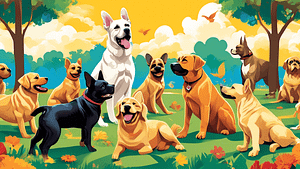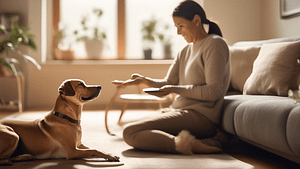Get your free Book Here

Unleashing the Power of Positive Dog Training: A Comprehensive Guide
Have you ever wondered how to turn your furry friend into the best-behaved pup on the block? Well, you’re in for a treat! We’re about to dive into the world of positive dog training and trust us, it’s going to be a tail-wagging adventure. So, grab a cup of coffee, get comfy, and let’s embark on this journey together!
Why Positive Dog Training Matters
Let’s face it, our dogs are more than just pets – they’re family. And just like any family member, we want them to be happy, healthy, and well-behaved. That’s where positive dog training comes in. It’s not just about teaching tricks; it’s about building a strong, loving bond with your furry friend.
Turn your dog into an Obedient, Loyal Pet In Just 5 Days
The Power of Positivity
Think about it – would you rather learn something new through encouragement or punishment? We’re guessing you’d pick encouragement, and guess what? Your dog feels the same way! Positive training focuses on rewarding good behavior instead of punishing bad behavior. It’s like giving your dog a high-five every time they do something right!
Building Trust and Confidence
When we use positive methods, we’re not just teaching commands; we’re building trust. Your dog learns that you’re a source of good things, not someone to be feared. This trust leads to confidence, and a confident dog is a happy dog!
Unlock a Complimentary Coloring Book by Joining Our Mailing List
Getting Started: The Basics of Positive Dog Training
Alright, let’s roll up our sleeves and get into the nitty-gritty of positive dog training. Don’t worry; it’s not rocket science – it’s actually pretty fun!
Setting the Stage for Success
Before we jump into training exercises, let’s make sure we’ve got the right setup:
- A quiet space free from distractions
- Plenty of yummy treats (your dog’s favorites!)
- A positive attitude and lots of patience
Remember, Rome wasn’t built in a day, and your dog won’t become a model citizen overnight. But with consistency and love, you’ll get there!

The Golden Rule: Timing is Everything
When it comes to positive reinforcement, timing is crucial. You want to reward your dog immediately after they perform the desired behavior. It’s like giving them a thumbs up and saying, “Yes! That’s exactly what I wanted!”
Essential Commands: The Building Blocks of Good Behavior
Now that we’ve got the basics down, let’s talk about some essential commands every well-behaved dog should know.
Sit: The Foundation of Obedience
Teaching your dog to sit is like teaching a kid to say “please” – it’s the foundation of good manners! Here’s how to do it:
- Hold a treat close to your dog’s nose
- Slowly move the treat up and back over their head
- As their nose follows the treat, their bottom will naturally lower
- As soon as their bottom hits the ground, say “Sit!” and give them the treat
Remember to practice this in short, fun sessions. Before you know it, your dog will be sitting like a pro!
Stay: The Art of Patience
“Stay” is a super useful command, but it can be a bit tricky for our energetic furry friends. Here’s how to teach it:
- Ask your dog to sit
- Open the palm of your hand in front of you, and say “Stay”
- Take a step back
- If your dog stays, give them a treat and lots of praise
- Gradually increase the distance and duration

The key here is to start small and build up slowly. Rome wasn’t built in a day, and your dog won’t master “stay” overnight!
Come: The Recall Command
“Come” is arguably one of the most important commands. It can keep your dog safe in potentially dangerous situations. Here’s how to teach it:
- Start in a quiet area
- Say your dog’s name followed by “Come!” in a happy, excited voice
- When they come to you, give them a treat and lots of praise
- Gradually practice this in different locations with more distractions
Remember, always make coming to you a positive experience. You want your dog to think, “Woohoo! My human called me. This is gonna be great!”

Dealing with Common Behavior Issues
Okay, we’ve covered the basics, but what about those pesky behavior problems that drive us up the wall? Don’t worry; we’ve got you covered!
Jumping Up: Keeping Four Paws on the Floor
We know your dog is just excited to see you, but jumping up can be annoying and even dangerous. Here’s how to nip this in the bud:
- When your dog jumps, turn your back and ignore them
- Only give attention when all four paws are on the floor
- Reward calm behavior with treats and praise
Remember, consistency is key. Make sure everyone in the household follows the same rules!
Leash Pulling: Walking in Harmony
Walking should be enjoyable for both you and your dog, not a tug-of-war match! Try this method:
- When your dog pulls, stop walking
- Wait for them to come back to you or loosen the leash
- As soon as there’s slack in the leash, start walking again
- Reward your dog for walking nicely beside you
It might take a while, but eventually, your dog will learn that pulling gets them nowhere, while walking nicely gets them where they want to go!

Excessive Barking: Finding Their Indoor Voice
A little barking is normal, but non-stop yapping can drive anyone crazy. Here’s how to help your dog find their indoor voice:
- Identify what triggers the barking
- Teach the “Quiet” command by saying “Quiet” when they stop barking, even for a second
- Reward quiet behavior with treats and praise
- Gradually increase the duration of quiet time before rewarding
Remember, some breeds are naturally more vocal than others. Be patient and consistent in your training.
Advanced Training: Taking it to the Next Level
So, your dog has mastered the basics? Awesome! Let’s kick things up a notch with some advanced training techniques.
Clicker Training: Precision in Communication
Clicker training is like giving your dog a clear, consistent “Yes!” signal. Here’s how it works:
- Get a clicker (a small device that makes a clicking sound)
- Click and immediately give a treat (this is called “charging” the clicker)
- Use the clicker to mark the exact moment your dog performs the desired behavior
- Follow the click with a treat
The great thing about clicker training is its precision. It allows you to pinpoint exactly what behavior you’re rewarding.

Target Training: Teaching Your Dog to Touch
Target training is super versatile and can be used to teach all sorts of behaviors. Here’s how to get started:
- Present a target (like your hand or a stick) to your dog
- When they naturally sniff or touch it, click (or say “Yes!”) and treat
- Gradually move the target around, rewarding your dog for touching it
- Start adding a cue word like “Touch”
Once your dog understands the concept, you can use target training for all sorts of things – from teaching tricks to helping with grooming!
The Importance of Mental Stimulation
Physical exercise is important, but don’t forget about mental stimulation! A bored dog is often a mischievous dog. Here are some ways to keep your pup’s mind sharp:
Puzzle Toys: Brain Teasers for Dogs
Puzzle toys are a great way to keep your dog entertained and mentally stimulated. They come in all shapes and sizes, from simple treat-dispensing balls to complex puzzles. Start with easier ones and gradually increase the difficulty as your dog becomes a puzzle-solving pro!
Nose Work: Tapping into Natural Instincts
Nose work games tap into your dog’s natural scenting abilities. Here’s a simple game to try:
- Hide treats around the house
- Encourage your dog to “Find it!”
- Praise and celebrate when they find each treat
As your dog gets better, you can make the hiding spots trickier or even introduce specific scents for them to find.

Socialization: Raising a Well-Rounded Dog
Socialization is crucial for raising a confident, well-adjusted dog. It’s about exposing your pup to a variety of people, animals, and environments in a positive way.
The Importance of Early Socialization
The prime socialization period for puppies is between 3 and 16 weeks. During this time, it’s crucial to expose them to as many positive experiences as possible. This doesn’t mean overwhelming them – always let your pup set the pace!
Socializing Adult Dogs
If you’ve adopted an adult dog or missed the prime socialization window, don’t worry! It’s never too late to socialize your dog. Just take things slow and always keep experiences positive.

Safe Socialization Techniques
Here are some safe ways to socialize your dog:
- Invite friends over (start with calm, dog-friendly people)
- Go for walks in different neighborhoods
- Visit pet-friendly stores
- Arrange playdates with well-behaved dogs
- Expose them to different sounds (like thunderstorm recordings) at a low volume
Remember, the key is to make these experiences positive. Lots of treats and praise go a long way!
The Role of Exercise in Training
We can’t talk about dog training without mentioning exercise. A tired dog is often a well-behaved dog!
Physical Exercise: Burning Off Energy
Different breeds have different exercise needs, but all dogs benefit from regular physical activity. Here are some ideas:
- Daily walks
- Fetch in the backyard
- Swimming (for water-loving breeds)
- Agility courses (you can set up a simple one at home!)
Remember, a well-exercised dog is more likely to focus during training sessions.
Mental Exercise: Tiring Out the Mind
Mental exercise can be just as tiring as physical exercise for dogs. Try these:
- Training sessions (learning new tricks is mentally exhausting!)
- Food puzzles
- Scent games
- Hide and seek
Combining physical and mental exercise is the perfect recipe for a happy, well-behaved dog!

Consistency is Key: Getting the Whole Family Involved
For training to be effective, everyone in the household needs to be on the same page. Here’s how to get the whole family involved:
Setting Clear Rules
Sit down as a family and decide on the house rules for your dog. Will they be allowed on the furniture? What commands will everyone use? Having clear, consistent rules makes it easier for your dog to understand what’s expected of them.
Assigning Training Tasks
Make training a family affair! Assign different training tasks to each family member. Maybe one person is in charge of the “Sit” command, while another focuses on leash training. This not only shares the responsibility but also helps your dog learn to respond to different people.
Celebrating Successes Together
Don’t forget to celebrate your dog’s progress as a family! Whether it’s mastering a new trick or going a whole day without an accident, acknowledging these milestones together reinforces positive behavior and strengthens the bond between your dog and the entire family.
Troubleshooting: When Training Isn’t Working
Sometimes, despite our best efforts, training doesn’t seem to be working. Don’t get discouraged! Here are some things to consider:
Reassessing Your Approach
If a particular training method isn’t working, it might be time to try a different approach. Every dog is unique, and what works for one might not work for another. Be flexible and willing to adjust your techniques.

Checking for Health Issues
If your dog suddenly starts having behavior issues or seems unable to learn, it might be worth a trip to the vet. Sometimes, health problems can manifest as behavior changes.
Seeking Professional Help
There’s no shame in asking for help! A professional dog trainer or behaviorist can provide personalized advice and help you overcome specific challenges. They can assess the situation and develop a training plan tailored to your dog’s needs.
The Lifelong Journey of Dog Training
Remember, dog training isn’t a one-and-done deal. It’s a lifelong journey of learning and bonding with your furry friend. Even old dogs can learn new tricks!
Continuing Education
Keep challenging your dog with new tricks and activities. This not only keeps their mind sharp but also strengthens their bond. Plus, it’s fun!
Adapting to Life Changes
As your dog ages or your life circumstances change, you might need to adjust your training approach. Be patient and understanding during these transitions.

Enjoying the Process
Above all, enjoy the journey! Training shouldn’t be a chore – it’s a chance to spend quality time with your best friends and watch them grow and learn.
Wrapping Up: The Joy of a Well-Trained Dog
Whew! We’ve covered a lot of ground, haven’t we? From basic commands to advanced techniques, we’ve explored the wonderful world of positive dog training. Remember, the goal isn’t perfection – it’s about building a strong, loving relationship with your furry friend.
A well-trained dog is a joy to be around. They’re confident, happy, and a true part of the family. But more than that, the training process strengthens the bond between you and your dog in ways that nothing else can.
So, grab those treats, put on your patience hat, and dive into the rewarding world of dog training. Your furry friend is ready to learn, and we bet you’ll learn a thing or two along the way too!
FAQs
- Q: How long does it take to train a dog?
A: The time it takes to train a dog varies depending on the dog’s age, breed, and individual personality. Some basic commands can be learned in a few weeks, while more complex behaviors may take months. Remember, training is an ongoing process throughout your dog’s life. - Q: Can old dogs really learn new tricks?
A: Absolutely! While puppies might learn more quickly, older dogs are certainly capable of learning new things. In fact, mental stimulation from training can be great for senior dogs. - Q: What if my dog doesn’t seem food-motivated?
A: Not all dogs are food-motivated. Try using toys, praise, or playtime as rewards instead. The key is to find what your dog values most. - Q: How often should I train my dog?
A: Short, frequent training sessions are often more effective than long, infrequent ones. Aim for 5-10 minute sessions a few times a day. - Q: What should I do if my dog becomes frustrated during training?
A: If your dog seems frustrated, it’s best to end the session on a positive note. Go back to a command they know well, reward them, and try again later. Remember to break complex tasks into smaller, manageable steps.

Click here to get more details on your Breed!
- French Bulldog: Consistently high in AKC registrations, known for their compact size and playful personalities, appealing to many lifestyles.
- Golden Retriever: Classic family dog, known for intelligence and friendly nature, often favored for their versatility.
- Labrador Retriever: Another all-around favorite, known for loyalty and eagerness to please, popular for their adaptability.
- German Shepherd: High AKC registration, known for intelligence, trainability, and versatility, often chosen for their protective instincts.
- Poodle: High AKC registration, especially Standard Poodles, is known for its intelligence and hypoallergenic coat, appealing to those with allergies.
- Australian Shepherd: Popular for energy and intelligence, often chosen by active owners, but may not be suitable for all households.
- Bulldog: Distinctive look and gentle temperament, but can be prone to health issues, requiring dedicated care.
- Beagle: Playful nature and distinctive baying sound, but can be stubborn and require consistent training.
- Yorkshire Terrier: Small and affectionate, popular for their compact size, but require grooming and can be prone to health issues.
- Rottweiler: Powerful and loyal, often chosen for their protective instincts, but require experienced owners and socialization.
Unlock a Complimentary Coloring Book by Joining Our Mailing List
As an affiliate, I earn from qualifying purchases. This means that if you click on a link provided and make a purchase, I may receive a commission at no extra cost to you.








